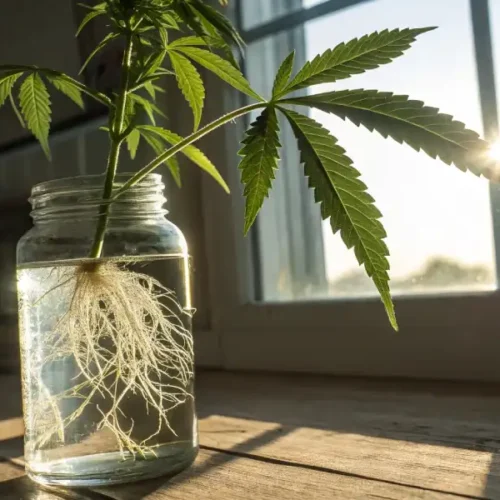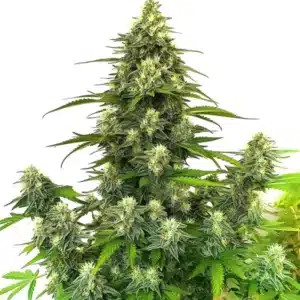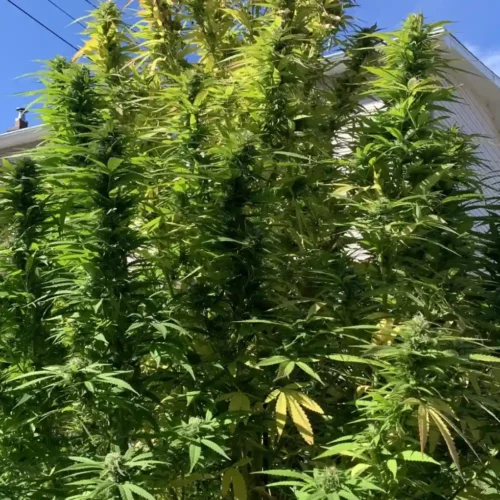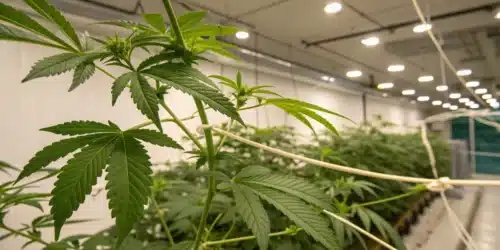Topping autoflowers is a topic that sparks a lot of debate among growers. Some swear by it, while others steer clear, fearing it may stunt growth or harm their plants. But here’s the truth: with the right approach, topping can be a powerful technique to maximize your autoflowering cannabis plants’ potential. In this article, we’ll delve deep into the world of topping autoflowers, exploring its benefits, challenges, and best practices to ensure you get the most out of your grow.
What Is Topping in Autoflowers?
Topping is a technique used to manipulate the growth of your cannabis plant. By cutting off the top of the plant, you encourage it to grow two new main colas instead of one. This can potentially double your plant’s yield, provided it’s done correctly. While topping is more commonly associated with photoperiod plants, it can be applied to autoflowers as well, albeit with a few key differences.
Why Consider Topping for Autoflowers?
So, why should you consider topping your autoflowers? The answer lies in the desire to maximize yield and control the plant’s structure. Autoflowers are known for their rapid growth cycle, which typically limits the amount of training you can do. However, topping, when done at the right time, can enhance light exposure and improve overall plant health. It’s a technique that requires precision and timing, but the potential rewards are worth the effort.
Promos & Deals
The Benefits of Topping Autoflowers
Topping autoflowers isn’t just about getting more buds it’s about growing healthier, more robust plants. Let’s explore the key benefits that topping can offer your autoflowers.
Increased Light Exposure
One of the primary benefits of topping is increased light exposure. By creating two main colas instead of one, you allow more of the plant to receive direct light. This can lead to more even growth and ultimately a more abundant harvest. Light is a critical factor in cannabis cultivation, and topping helps ensure that more of your plant benefits from the available light.
Potential for Higher Yields
When done correctly, topping can significantly increase your yield. By encouraging the plant to grow more main colas, you’re effectively increasing the number of bud sites. More bud sites typically mean a higher yield. For growers looking to maximize their output, this is one of the most compelling reasons to top their autoflowers.
Enhanced Plant Structure
Topping also helps improve the overall structure of the plant. Instead of growing tall and lanky, topped plants tend to be bushier and more stable. This is particularly beneficial for indoor growers who need to manage their plants’ height. A well-structured plant is easier to manage and less likely to suffer from issues like light burn or uneven growth.

The Risks and Challenges of Topping Autoflowers
While topping offers many benefits, it’s not without its challenges. Autoflowers, in particular, require careful consideration before you decide to top them. Let’s take a closer look at some of the risks involved.
Limited Recovery Time
Autoflowers are on a strict timeline. Unlike photoperiod plants, which can stay in the vegetative stage as long as you like, autoflowers transition to flowering automatically based on age. This means that any stress, including topping, must be done early and carefully, as there’s limited time for the plant to recover before it starts flowering. If you top too late, you risk stunting the plant’s growth or affecting its yield.
Potential for Stunted Growth
Stunted growth is a real risk when topping autoflowers. Because they grow and flower so quickly, any setback can have a lasting impact. If the plant doesn’t recover quickly from topping, it may not reach its full potential. This can result in smaller plants with fewer buds, defeating the purpose of topping in the first place.
Stress on the Plant
Topping is a stressful process for any plant, and autoflowers are no exception. When you cut off the top of the plant, it must redirect its energy to heal and grow new colas. If the plant is already under stress (whether from environmental factors, nutrient imbalances, or pests) topping can exacerbate these issues. This makes it crucial to ensure that your plants are healthy and well cared for before attempting to top them.
Best Practices for Topping Autoflowers
To successfully top autoflowers, you need to follow best practices that take into account their unique growth patterns. Technique, timing, and aftercare are all critical factors in ensuring a successful topping experience.
Timing: When to Top Your Autoflower
Timing is everything when it comes to topping autoflowers. The ideal time to top is when the plant has developed 3 to 4 nodes, typically around week 3. This ensures that the plant has enough time to recover and develop new growth before it enters the flowering stage. Topping too early can stunt the plant, while topping too late can reduce its yield. Paying close attention to your plant’s growth and topping at the right moment is key to success.
Tools and Techniques for Topping
Using the right tools and techniques is essential for topping success. You’ll need a sharp, sterilized pair of scissors or pruning shears to make a clean cut. The cut should be made just above the third or fourth node, ensuring that you leave enough growth below for the plant to recover. Some growers prefer to use their fingers to pinch off the top, but this method can be less precise and increase the risk of damage. Whichever method you choose, ensure that the cut is clean to minimize stress on the plant.
Post-Topping Care
After topping, your plant will need some extra care to recover and thrive. Ensure it receives adequate light, water, and nutrients to support new growth. Monitoring the plant closely for signs of stress is essential during this period. If you notice any issues, such as wilting or discoloration, address them immediately to prevent long-term damage. Proper post-topping care will help your plant bounce back quickly and continue growing strong.
Comparing Topping with Other Training Methods
Topping isn’t the only training method available to cannabis growers. There are several other techniques that can be used to manage plant growth and maximize yields. Let’s compare topping with some of the most common alternative methods.
Topping vs. Low-Stress Training (LST)
Low-Stress Training (LST) is another popular method for managing plant growth. Unlike topping, which involves cutting the plant, LST involves gently bending and tying down the branches to create a more even canopy. LST is less stressful for the plant and doesn’t require any recovery time, making it a safer option for autoflowers. However, LST may not produce as dramatic an increase in yield as topping can. The choice between topping and LST often comes down to the grower’s experience level and their willingness to take on more risk for potentially greater rewards.
Topping vs. Fimming
Fimming is a technique similar to topping but with a twist. Instead of cutting off the entire top of the plant, you remove about 75% of the top growth. This encourages the plant to develop multiple new colas, similar to topping, but with a less severe impact on the plant. Fimming is often seen as a middle ground between topping and LST it can increase yield without the same level of stress as topping. However, like topping, timing and technique are crucial to success. Fimming is slightly more forgiving, making it a good option for growers who want to experiment with plant training.
Which Method is Best for Autoflowers?
Deciding which training method is best for your autoflowers depends on your goals and your experience level. Topping offers the potential for higher yields and improved plant structure but comes with more risk. LST is safer and less stressful for the plant but may not produce as dramatic results. Fimming strikes a balance between the two, offering some of the benefits of topping with less risk. Ultimately, the best method is the one that aligns with your growing style and the specific needs of your plants.
Topping Autoflowers in Different Growing Mediums
The growing medium you choose for your autoflowers can significantly impact the topping process and the plant’s ability to recover. Different mediums provide varying levels of support, nutrients, and water retention, all of which can influence the success of topping.
Topping in Soil vs. Hydroponics
When growing in soil, the natural buffer provided by organic matter can make topping a bit more forgiving. Soil-grown plants tend to have a steadier nutrient release, which helps support recovery after topping. However, the recovery time might be slightly longer compared to hydroponics because soil environments can be slower to react to changes.
In contrast, hydroponic systems allow for more precise control over nutrient delivery and water availability, often resulting in faster recovery times after topping. The direct access to nutrients in a hydroponic setup can lead to more vigorous growth, which can be beneficial when trying to maximize the effects of topping. However, hydroponics also requires more precise monitoring, as any nutrient imbalances can quickly affect the plant’s health.
The Impact of Medium on Recovery Time
The choice of medium (whether soil, coco coir, or hydroponics) affects the plant’s recovery time after topping. Soil and coco coir tend to have a more gradual nutrient release, which can provide a steady supply of what the plant needs to heal. However, these mediums might slow down the plant’s recovery compared to hydroponic systems, which deliver nutrients more directly and efficiently.
If you’re growing in coco coir, the medium’s ability to retain water and nutrients while maintaining good aeration makes it an excellent choice for topping. It combines the benefits of both soil and hydroponics, offering faster recovery times with a more forgiving nature. However, it’s crucial to ensure that the medium is consistently moist and nutrient-rich to support the plant’s regrowth after topping.
Adjusting Topping Techniques for Different Mediums
Depending on your growing medium, you may need to adjust your topping technique slightly. For instance, in hydroponic systems, where growth tends to be faster, you might need to top earlier to prevent the plant from outgrowing its space. In soil, you might opt for a more conservative approach, allowing the plant to establish itself fully before making any cuts.
In coco coir, you can apply topping techniques similar to those used in hydroponics, as the medium promotes rapid growth. However, it’s essential to monitor the moisture levels closely, as coco coir can dry out faster than soil, especially under high-intensity lights. Adjusting your watering and feeding schedule to accommodate the medium’s characteristics will help ensure a successful topping.
Troubleshooting Topping Issues
Even with careful planning and execution, topping can sometimes lead to issues that need to be addressed promptly to ensure your autoflowers thrive.
Identifying Signs of Stress After Topping
After topping, it’s crucial to monitor your plants for signs of stress. Common indicators include wilting, yellowing of leaves, and slowed growth. These symptoms can suggest that the plant is struggling to recover, possibly due to inadequate nutrients, poor environmental conditions, or incorrect timing of the topping.
If you notice these signs, take immediate action by checking your nutrient levels, adjusting your watering schedule, and ensuring that the plant is not exposed to extreme temperatures or humidity levels. Stress can significantly impact the plant’s ability to produce a healthy yield, so early detection and correction are key to recovery.
How to Revive a Stunted Autoflower
If your autoflower becomes stunted after topping, all is not lost. The first step is to diagnose the cause of the stunting. Check for nutrient deficiencies or excesses, as both can hinder the plant’s growth. Ensure that your lighting is adequate and that the plant is receiving the appropriate amount of light for its stage of growth.
Once the issue is identified, make the necessary adjustments to the growing environment. Consider giving the plant a gentle foliar spray with a diluted nutrient solution to help it recover faster. Reducing stress by optimizing the growing conditions can often help the plant bounce back, although it may take some time.
Dealing with Uneven Growth After Topping
Sometimes, topping can result in uneven growth, where one side of the plant grows more vigorously than the other. This can be due to uneven light distribution or differences in how the plant directs its energy after topping. To address this, try rotating the plant regularly to ensure even light exposure on all sides.
You can also use Low-Stress Training (LST) techniques to gently guide the plant’s growth, helping to balance out the canopy. Tying down the more vigorous branches can encourage the less dominant ones to catch up, resulting in a more even and productive plant. Adjusting your light positioning or using supplemental lighting can also help ensure that all parts of the plant receive equal light.
Genetics and Their Impact on Topping Success
Not all autoflower strains respond to topping in the same way. The plant’s genetics play a significant role in determining how well it will recover and benefit from topping.
Selecting Autoflower Strains for Topping
When choosing autoflower strains for topping, it’s important to select those known for their robustness and vigorous growth. Strains with strong genetics are more likely to recover quickly from the stress of topping and continue growing vigorously. Look for strains that have been bred for resilience, as these are more likely to handle the stress of topping without a significant drop in yield or quality.
Some autoflower strains are specifically bred to be more tolerant of training techniques, including topping. Researching the strain’s background and looking for grower reviews can provide valuable insights into how well a particular strain responds to topping.
Genetic Traits that Influence Recovery
Certain genetic traits can influence how well an autoflower recovers after topping. For example, strains with a high growth rate and strong root systems tend to recover more quickly from stress. These traits allow the plant to bounce back and redirect energy to new growth points more effectively.
On the other hand, strains that are naturally slower-growing or more delicate may not respond as well to topping. These plants might struggle to redirect energy and could end up with reduced yields. Knowing the genetic makeup of your autoflower can help you make informed decisions about whether topping is the right approach.
How Breeding Impacts Topping Viability
Breeding plays a crucial role in determining a strain’s viability for topping. Autoflowers that are crossbred with photoperiod strains may inherit traits that make them more suitable for topping, such as increased vigor and a longer vegetative period. These hybrid strains often have the resilience needed to recover from topping and continue producing high yields.
Breeders who focus on creating autoflowers with enhanced training capabilities may specifically select for traits that promote strong, even growth after topping. If topping is a key part of your growing strategy, choosing strains from breeders known for these traits can significantly increase your chances of success.
Timing Topping with Nutrient Feeding Schedules
Synchronizing topping with your nutrient feeding schedule is essential to support your autoflowers through the stress of topping and ensure optimal growth.

Topping for autoflowers: Aligning Topping with Vegetative Nutrient Boosts
To maximize the benefits of topping, it’s important to align the process with your plant’s vegetative nutrient boosts. Just before and after topping, consider increasing the levels of nitrogen in your feeding schedule. Nitrogen is crucial for supporting new growth, especially after the plant has been topped and is directing energy toward developing new colas.
Ensure that your feeding schedule is consistent and that your plants are receiving the nutrients they need to recover quickly and continue growing. By aligning topping with nutrient boosts, you can minimize stress and encourage faster recovery.
Topping for autoflowers: Post-Topping Nutrient Requirements
After topping, your autoflowers will have specific nutrient requirements to support recovery and new growth. In addition to nitrogen, phosphorus and potassium are essential for root development and overall plant health. Consider using a balanced fertilizer that provides these nutrients in the right proportions for the vegetative stage.
It’s also important to avoid overfeeding, as this can lead to nutrient burn and further stress. Instead, focus on providing a steady, balanced supply of nutrients that supports the plant’s recovery and prepares it for the flowering stage.
Topping for autoflowers: Timing Topping Around Feeding Intervals
Proper timing of topping around feeding intervals can help ensure that your plants have the resources they need to recover. Ideally, topping should be done shortly after a feeding, when the plant is at its peak nutrient uptake. This will give the plant the energy it needs to heal quickly and start producing new growth.
Avoid topping right before a planned flush or a change in the feeding schedule, as this can disrupt the plant’s recovery process. By carefully timing your topping around feeding intervals, you can maximize the benefits and minimize the risks.
Comparing Topping Outcomes Across Grow Cycles
Tracking and comparing the outcomes of topping across different grow cycles can provide valuable insights into how the technique affects your autoflowers over time.
How Topping Affects Subsequent Harvests
One of the key benefits of topping is the potential to increase yields in subsequent harvests. By creating more colas, topping can lead to larger overall harvests, especially when combined with proper nutrient management and environmental controls. However, the success of topping in one grow cycle doesn’t always guarantee the same results in the next.
To maximize the benefits of topping, it’s important to track your results over multiple grow cycles. This includes monitoring the number of colas produced, the size and density of the buds, and the overall health of the plants. By comparing these outcomes, you can refine your topping technique and make adjustments to improve future harvests.
Variations in Growth Patterns Across Different Cycles
Growth patterns can vary significantly across different grow cycles, even when using the same strain and topping technique. Factors such as environmental conditions, nutrient availability, and the timing of topping can all influence how the plant responds.
Tracking these variations can help you identify patterns and make adjustments for future grows. For example, if you notice that plants topped earlier in the vegetative stage tend to produce better results, you can adjust your timing accordingly. How topping affects growth patterns across cycles, you can fine-tune your approach for optimal results.
Long-Term Effects of Topping on Autoflower Genetics
Over time, the repeated topping of autoflowers can have long-term effects on the genetics of your plants. While most autoflowers are grown from seeds, some growers experiment with cloning or breeding their own strains. In these cases, it’s important to understand how topping might influence the genetic traits passed down to future generations.
Topping can promote traits such as bushier growth and increased resilience, but it can also introduce stress-related traits if not done carefully. If you’re involved in breeding or cloning, consider how your topping practices might affect the long-term viability and performance of your plants.
Environmental Factors Affecting Topping Success
Environmental factors play a crucial role in the success of topping. By optimizing conditions, you can enhance the plant’s ability to recover and thrive after topping.
Here’s how temperature impacts post-topping recovery
Temperature is a critical factor in the recovery process after topping. Autoflowers prefer a stable environment with temperatures between 70-85°F (21-29°C) during the day and slightly cooler at night. After topping, maintaining a consistent temperature within this range is essential for reducing stress and promoting rapid healing.
Avoid exposing your plants to extreme temperatures, as this can slow down recovery and negatively impact growth. High temperatures can cause wilting and nutrient deficiencies, while low temperatures can stunt growth and lead to poor bud development. By controlling the temperature, you create an environment conducive to recovery and strong, healthy growth.
Humidity Levels and Their Impact on Healing
Humidity also plays a significant role in post-topping recovery. Autoflowers typically thrive in humidity levels between 50-60% during the vegetative stage. After topping, maintaining this humidity range can help prevent the plant from drying out and support faster healing.
Too much humidity, however, can increase the risk of mold and mildew, especially in the dense growth that results from topping. It’s important to monitor humidity levels closely and ensure good air circulation to reduce the risk of these issues. Adjusting humidity levels based on the stage of growth and the plant’s needs will promote better recovery and overall health.
Optimizing Airflow to Support New Growth
Good airflow is essential for topped plants, as it helps prevent the buildup of moisture and supports strong, healthy growth. After topping, ensure that your grow space has adequate ventilation to keep the air moving and reduce the risk of mold and mildew.
Fans can be used to gently circulate air around the plants, helping to strengthen stems and promote even growth. Proper airflow also helps maintain optimal temperature and humidity levels, further supporting the plant’s recovery and development after topping. By optimizing airflow, you can create an environment where your autoflowers can thrive.

FAQs
What is topping autoflowers, and why do growers use it?
Topping autoflowers is a training technique where the top of the plant is cut off to encourage the growth of two main colas instead of one. This method helps improve light exposure, enhances plant structure, and can potentially increase yields when done correctly.
When is the best time to top autoflowering cannabis plants?
The ideal time to top autoflowers is when they have developed 3 to 4 nodes, typically around week 3 of growth. Topping at this stage gives the plant enough time to recover before entering the flowering phase, reducing the risk of stunted growth.
What are the risks of topping autoflowers?
Topping autoflowers carries some risks, including limited recovery time due to their short life cycle, potential stunted growth if done too late, and added stress on the plant. Growers should ensure their plants are healthy and use proper techniques to minimize these challenges.
















